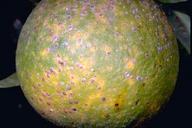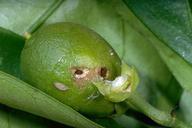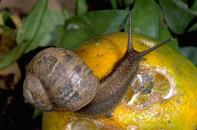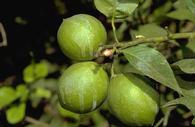Names link to more information on identification and management.
Click on photos to enlarge
Discoloring
or shallow scarring of the rind |

Citrus thrips scarring
Identification tip: Scabby, gray, or silvery
scars on the rind, usually at the stem end of the fruit,
result from citrus thrips feeding under the calyx when
fruit are small. The ring pattern around the button helps
to distinguish thrips scars from damage caused by insects
or wind scars and other fruit diseases and disorders. When
amorbia causes ring scars, the chewing is deeper in the
rind.
|

Citrus peelminer tunnel
Identification tip: Larvae of a tiny moth cause
winding tunnels by feeding just under the top layer of
the rind, usually on the inward-facing fruit surface.
|

Potato leafhopper damage
Identification tip: Leafhopper feeding causes roundish
discoloring on fruit. Injured blotches are typically clustered
in groups. Scars usually develop on older fruit during
late summer or fall when leafhoppers migrate into citrus.
|

California red scale mottling
Identification tip: Armored scale feeding can
discolor rinds. Look for the orange to brown, roundish
covers on twigs or on discolored fruit and leaves. These
covers can be removed to reveal the soft-bodied armored
scales feeding underneath.
|

Citrus red mite stippling
Identification tip: Bleached, pale, or silverish
discoloring on the rind (left in photo) occurs when high
citrus red mite populations feed on fruit. Greenhouse thrips,
twospotted spider mite, and Yuma spider mite can also bleach
fruit.
|

Citrus rust mite russeting
Identification tip: Rind discoloration varies
from dark brown to pale gray, depending on cultivar and
maturity of fruit infested by rust mite (also called silver
mite). Broad mite, peach silver mite, twospotted mite,
red mite, and Yuma spider mite are other
mites or spider mites that
discolor rinds.
|
Deep
gouging or chewing of the rind—Top
of page |

European earwig scarring
Identification tip: Irregularly shaped chewing on small fruit can
be caused by earwigs. Damage is most prevalent on young trees with trunk wraps,
on lower canopy fruit of trees that are not skirt-pruned, and where leaf litter
or other debris on soil provides pest shelter.
|

Forktailed bush katydid damage
Identification tip: Katydid nymph feeding on
young fruit causes scars that are deeper than damage from
citrus thrips or mechanical injury. Some leaf chewing is
usually present where katydids occurred.
|

Forktailed bush katydid
Identification tip: Katydid damage is typically a single circular
scar, usually in the midsection of fruit, often on the sheltered side facing
in toward the trunk. This injury occurred when a nymph chewed the small, immature
fruit.
|

Caterpillar damage
Identification tip: Fairly deep chewed areas in young fruit, but
generally not circular like katydid, can be caused by larvae of several species
of large moths, including, California orangedog, citrus
cutworm, and orange tortrix. Caterpillars
are the only citrus pest that chew both fruit and leaves and (in some species)
produce silk webbing.
|

Light brown apple moth
Identification tip: Young amorbia larvae
feed under the calyx of fruit are the common cause of a circular scar around
the button. Less often omnivorous leafroller, orange
tortrix, and (in Southern California only) pink
scavenger caterpillar cause button-end scars. In comparison with scarring
by citrus thrips, caterpillar chewing is deeper and webbing may be present. If
amorbia-like damage is unusually abundant, suspect the exotic light
brown apple moth. Report to agricultural officials any suspected finding
of this pest.
|

Citrus cutworm
Identification tip: Cutworm feeding when the
fruit was young caused this irregular scarring. When cutworms
chew circular scars, their injury closely resembles katydid
damage. Cutworm injury typically forms a meandering pattern,
sometimes at multiple locations on a fruit. Katydids usually
scar only a single spot.
|

Caterpillar scars and webbing
Identification tip: Fruittree leafroller sometimes
chews older fruit as shown here. Snails and occasionally other caterpillars (amorbia,
omnivorous leafroller, and orange tortrix) also can chew older fruit. Most fruit
chewing pests (such as earwigs and katydids) damage only young fruit, but damage
that occurred when fruit were young may be overlooked until fruit mature.
|

Brown garden snail
Identification tip: Where snails chewed leaves
and gouged fruit, their
feces and wet, slimy or dry, silvery trails are often visible
on surfaces. Snail shells can be observed during the day
on bark, around sprinklers, or by inspecting under trunk
wraps, or digging in leaf litter. Snail damage is heaviest
on fruit close to the ground.
|

Diaprepes
root weevil
Identification tip: This large weevil chews
leaves and fruit, leaves dark excrement on foliage, and
rolls or glues leaves during egg laying. The leaf chewing
and immature stages of the Fuller
rose beetle are very similar, so positively identify
any weevils found in citrus. Report to agricultural officials
any findings of the exotic diaprepes root weevil.
|
Surface
fouling of the rind, which can be scraped or washed off—Top
of page |

Citricola scale sooty mold
Identification tip: The dark, felty growth from sooty mold can be
scraped off of plant surfaces. Where sooty mold occurs, look for aphids, citricola
scale, black scale, brown soft scale, cottony cushion scale, mealybugs,
and whiteflies that excrete honeydew on which sooty mold fungi grow. Be alert
for the introduction of exotic Homoptera, such as the brown citrus aphid. Report suspected new pests to agricultural officials.
|

Citrus mealybug waxiness
Identification tip: Citrus mealybugs usually
occur in
protected places, such as where fruit touch. Several species of mealybug produce
pale, waxy material on fruit, leaves, or twigs. Whiteflies and cottony cushion
scale also produce whitish material on leaves or twigs, but not on fruit.
|

Glassy-winged sharpshooter excrement
Identification tip: Whitish excrement, often
in a runny pattern, is caused by this large species of
sharpshooter sucking xylem fluids.
|
Distorted
fruit or deep boring in the flesh |

Citrus bud mite on lemon
Identification tip: Feeding within the buds
on succulent new growth distorts young lemons, although
fruit is usually not this severely misshapen. Feeding and
damage occur in buds during the fall and winter, causing
injury to spring bloom and the resulting fruit. Bud mite
is usually a pest only on coastal lemons.
|

Fruit fly egg-laying stings
Identification tip: Several species of exotic fruit flies cause discolored
oviposition scars on the surface when they lay eggs that hatch into pale maggots
that feed inside fruit. Mediterranean fruit fly, Mexican fruit fly, and Oriental
fruit fly are among the tephritid flies periodically introduced and eradicated
in California. Report to agricultural officials any findings of tephritid fruit
flies.
|
|


